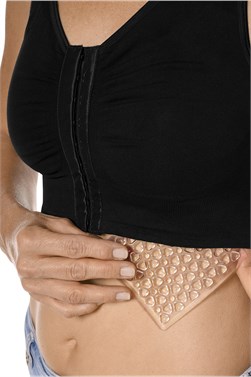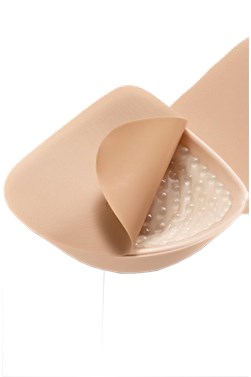Drain Wound Care
How to care for your surgical site after breast cancer surgery.
 Following a mastectomy, a woman may be discharged home with one or more drains coming from the incision site on her chest or under her arm.
Following a mastectomy, a woman may be discharged home with one or more drains coming from the incision site on her chest or under her arm.
Care instructions should be given prior to leaving the hospital on how often to observe and empty the drainage container. The purpose of the drain is to keep fluid from collecting in the area of your incision.
Fluids that collect in a wound create an environment for bacteria growth and an infection could develop. There are two types of drainage collectors commonly used today: a spring-loaded type and a bulb syringe. The bulb syringe is the most common and the most simple to use. The tubing coming from the incision to the collector is about 14″-18″ long. The collector has a loop on it that may be pinned inside or outside clothing to keep it secure.
 Better yet, comfortable clothing options, like drain management garments, are available to help you with drains after breast surgery. These cotton camisole-type garments are soft and comfortable with no internal seams to rub against the skin. A concealed front panel allows for pinning of the collector, or fastens it with velcro tabs; the garment can also hold soft cotton breast forms to give you a little shape as you recover and heal.
Better yet, comfortable clothing options, like drain management garments, are available to help you with drains after breast surgery. These cotton camisole-type garments are soft and comfortable with no internal seams to rub against the skin. A concealed front panel allows for pinning of the collector, or fastens it with velcro tabs; the garment can also hold soft cotton breast forms to give you a little shape as you recover and heal.
The following steps should be used to empty the drainage collector:
1. Wash your hands prior to emptying the container. Ask anyone who helps you to wash their hands as well.
2. Check your drains at least 4 times the first 24 hours after you get home and if the container is more than 2/3 full, empty the drainage into the measuring container. Use care not to touch the inside of the port or the stopper. Observe the draining for:
- Amount: The drainage will be greater just after surgery and will taper off as time goes by. Amounts of 100cc’s or greater are considered normal, decreasing to about 30 cc’s or less just before the drain is removed.
- Consistency: Initially, the consistency is slightly thicker than water and moves easily through the tubing. It should become thinner with time. If the fluid becomes thicker or will not move easily through the tubing, notify your surgeon.
- Color: The drainage will be cherry red for about 24 hours, but will become more yellow-straw colored prior to removal. If the drainage does not change from red after about two to three days, notify your surgeon.
3. To resume the suction on the container, press the container flat and reconnect the stopper. If the container will not hold suction, notify your surgeon.
4. Rinse the measuring container and wash your hands again. Secure the drain to your clothing with a safety pin, or place the drain in a pocket of loose fitting clothing.
5. The drains will be removed by the surgeon at a follow up appointment, usually 10 to 14 days post-op.
Drain and Wound Care

When you leave the hospital, your incision will be covered with a dry dressing. It is very important to keep this dressing dry and clean. Most surgeons prefer that you leave the dressing intact until you return for a follow up appointment, although some will allow you to remove the dressing at home. To remove the dressing yourself:
- First, wash your hands. Ask anyone assisting you to wash their hands as well.
- Carefully remove the tape, starting with one side, then the other.
- Double-bag the dressing and discard. Wash your hands again.
- The wound (incision) will appear slightly red along the edges. It should be only slightly swollen and no drainage should be present. Any other findings should be reported to the surgeon.











